Marketing and Strategic Resource Management Analysis for Woolworth's
VerifiedAdded on 2021/07/20
|13
|3341
|97
Report
AI Summary
This report delves into Woolworth's marketing and strategic resource management, examining key elements such as consumer behavior, strategic management processes, and the global business environment. It explores the scope of strategic management, encompassing domestic, international, and global business contexts, alongside the influence of the international business environment. The report analyzes techniques for business environment analysis, including competitive, customer, and Porter's Five Forces analyses, as well as environmental audits and Porter's Diamond. It also covers business strategies for managing the environment. The report emphasizes the importance of market research, marketing mix elements, and consumer data protection in achieving competitive advantage and profitability. Factors like economic, socio-cultural, political, legal, and technological environments are discussed. The report provides a comprehensive overview of Woolworth's marketing strategies and environmental analysis.
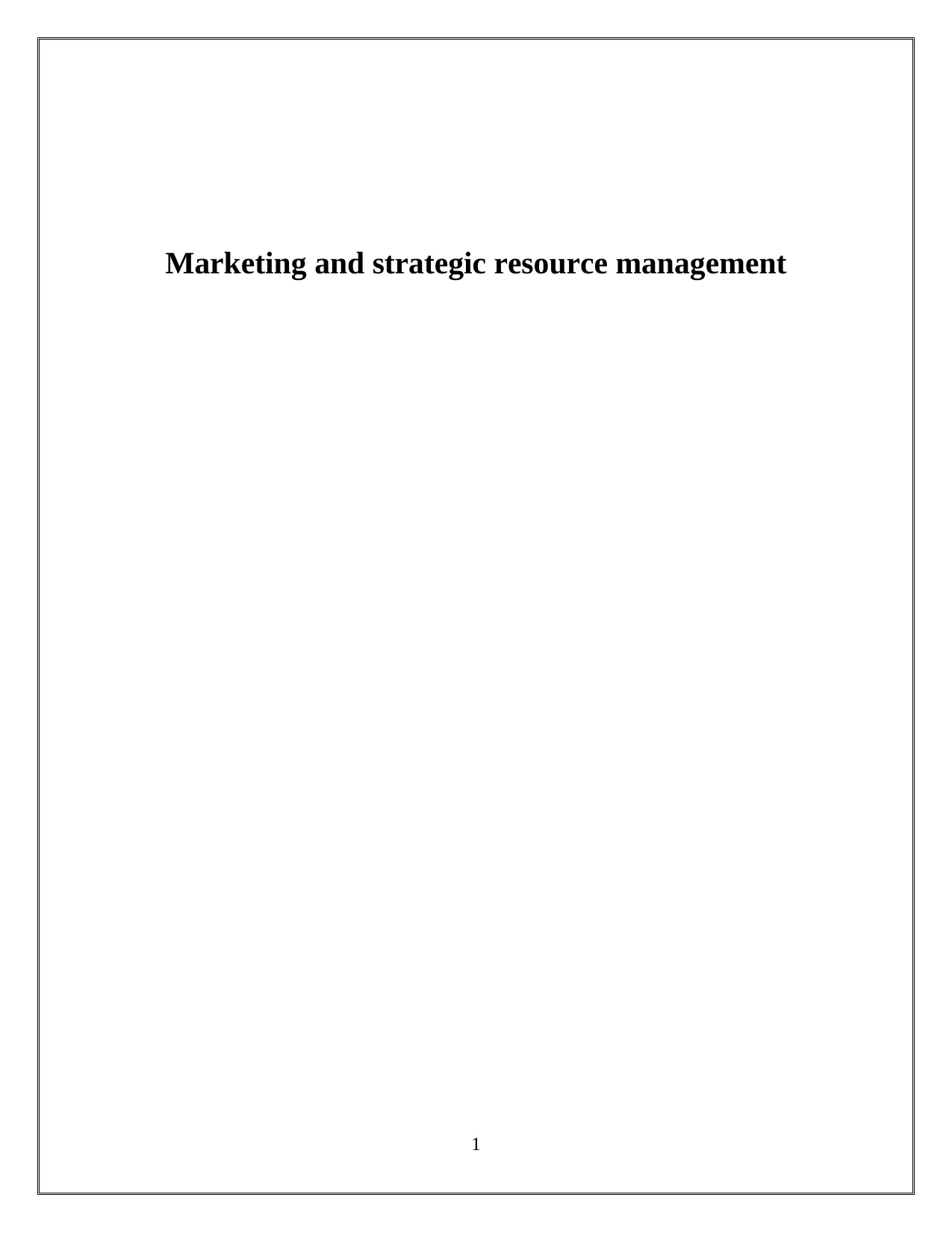
Marketing and strategic resource management
1
1
Paraphrase This Document
Need a fresh take? Get an instant paraphrase of this document with our AI Paraphraser
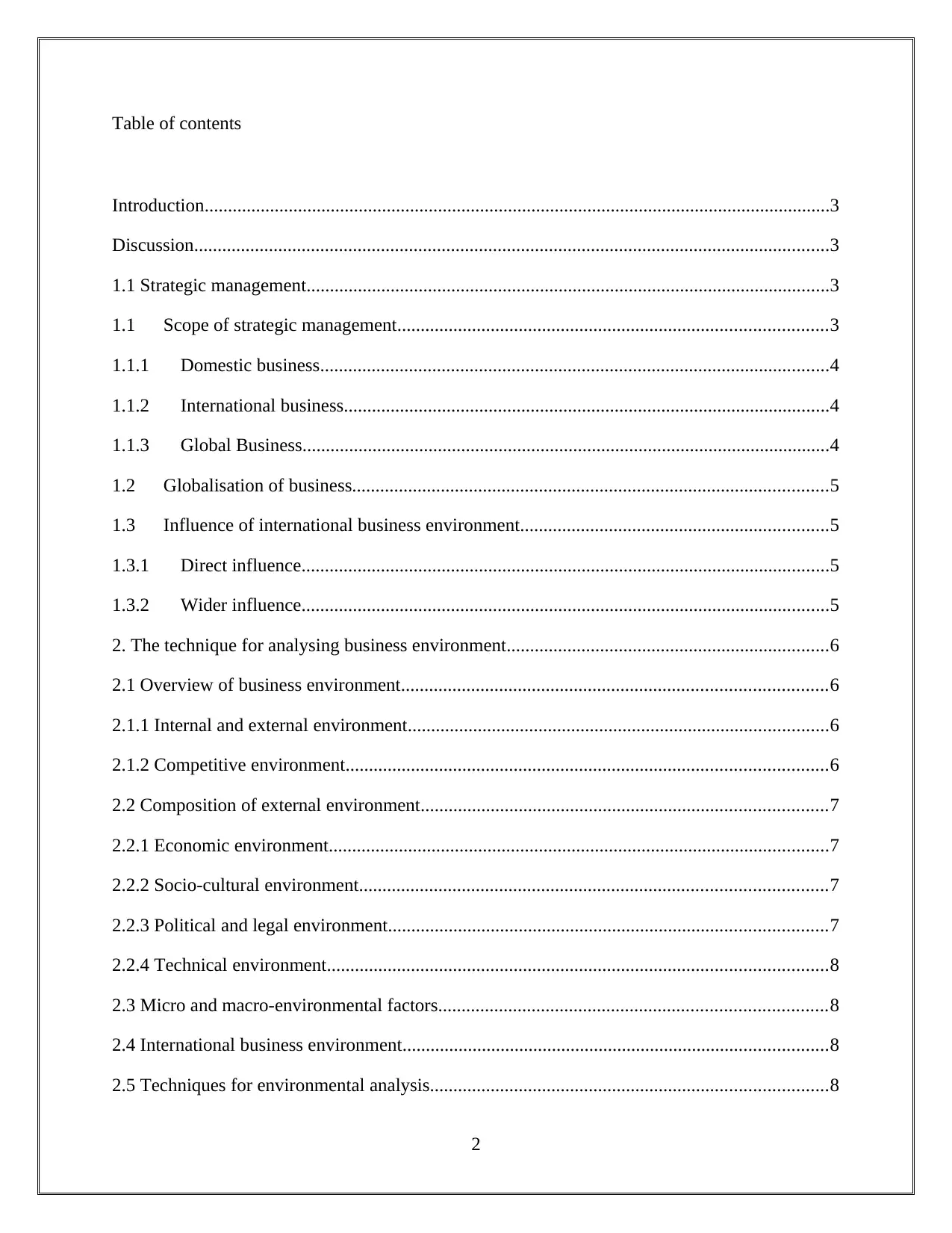
Table of contents
Introduction......................................................................................................................................3
Discussion........................................................................................................................................3
1.1 Strategic management................................................................................................................3
1.1 Scope of strategic management............................................................................................3
1.1.1 Domestic business.............................................................................................................4
1.1.2 International business........................................................................................................4
1.1.3 Global Business.................................................................................................................4
1.2 Globalisation of business......................................................................................................5
1.3 Influence of international business environment..................................................................5
1.3.1 Direct influence.................................................................................................................5
1.3.2 Wider influence.................................................................................................................5
2. The technique for analysing business environment.....................................................................6
2.1 Overview of business environment...........................................................................................6
2.1.1 Internal and external environment..........................................................................................6
2.1.2 Competitive environment.......................................................................................................6
2.2 Composition of external environment.......................................................................................7
2.2.1 Economic environment...........................................................................................................7
2.2.2 Socio-cultural environment....................................................................................................7
2.2.3 Political and legal environment..............................................................................................7
2.2.4 Technical environment...........................................................................................................8
2.3 Micro and macro-environmental factors...................................................................................8
2.4 International business environment...........................................................................................8
2.5 Techniques for environmental analysis.....................................................................................8
2
Introduction......................................................................................................................................3
Discussion........................................................................................................................................3
1.1 Strategic management................................................................................................................3
1.1 Scope of strategic management............................................................................................3
1.1.1 Domestic business.............................................................................................................4
1.1.2 International business........................................................................................................4
1.1.3 Global Business.................................................................................................................4
1.2 Globalisation of business......................................................................................................5
1.3 Influence of international business environment..................................................................5
1.3.1 Direct influence.................................................................................................................5
1.3.2 Wider influence.................................................................................................................5
2. The technique for analysing business environment.....................................................................6
2.1 Overview of business environment...........................................................................................6
2.1.1 Internal and external environment..........................................................................................6
2.1.2 Competitive environment.......................................................................................................6
2.2 Composition of external environment.......................................................................................7
2.2.1 Economic environment...........................................................................................................7
2.2.2 Socio-cultural environment....................................................................................................7
2.2.3 Political and legal environment..............................................................................................7
2.2.4 Technical environment...........................................................................................................8
2.3 Micro and macro-environmental factors...................................................................................8
2.4 International business environment...........................................................................................8
2.5 Techniques for environmental analysis.....................................................................................8
2
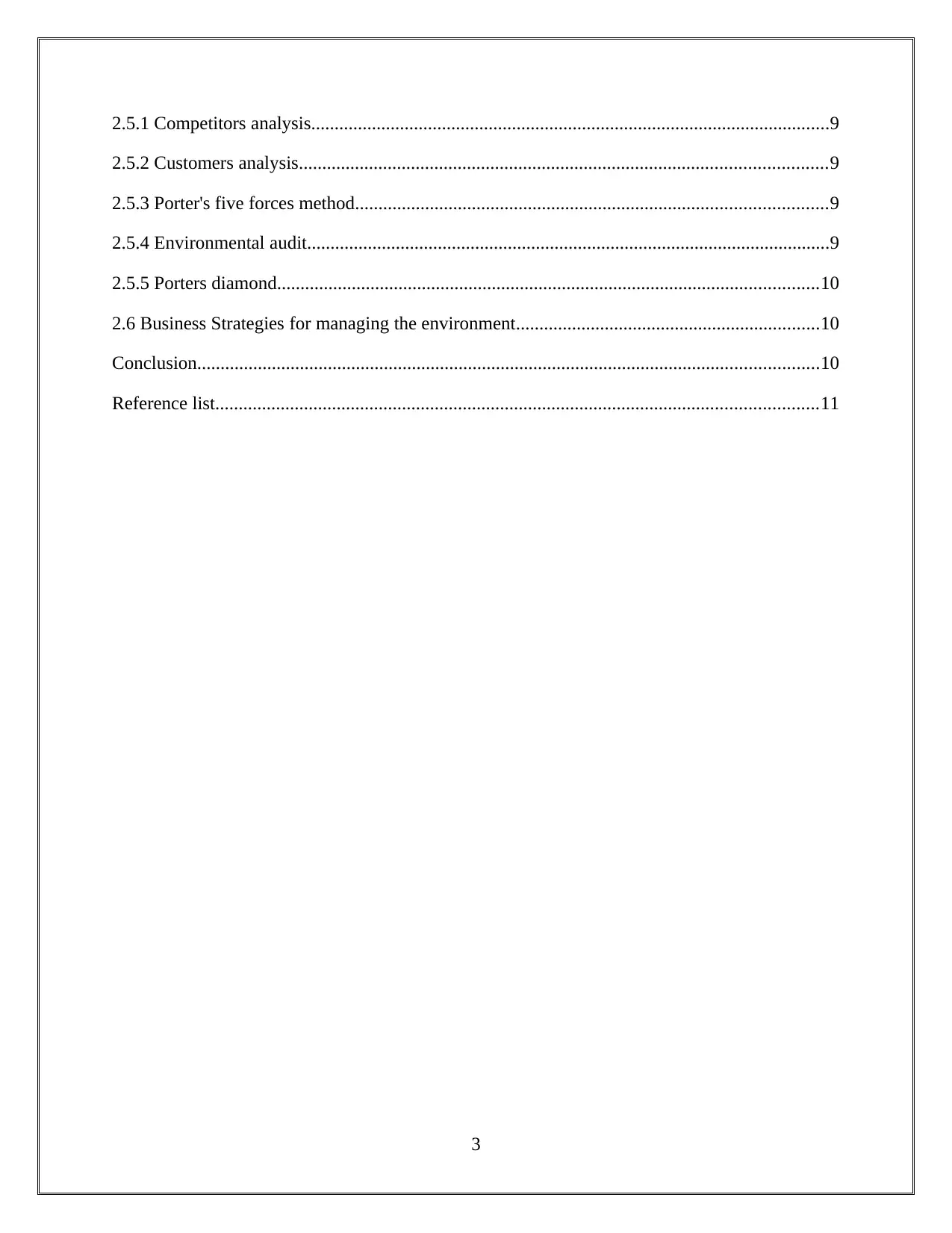
2.5.1 Competitors analysis...............................................................................................................9
2.5.2 Customers analysis.................................................................................................................9
2.5.3 Porter's five forces method.....................................................................................................9
2.5.4 Environmental audit................................................................................................................9
2.5.5 Porters diamond....................................................................................................................10
2.6 Business Strategies for managing the environment.................................................................10
Conclusion.....................................................................................................................................10
Reference list.................................................................................................................................11
3
2.5.2 Customers analysis.................................................................................................................9
2.5.3 Porter's five forces method.....................................................................................................9
2.5.4 Environmental audit................................................................................................................9
2.5.5 Porters diamond....................................................................................................................10
2.6 Business Strategies for managing the environment.................................................................10
Conclusion.....................................................................................................................................10
Reference list.................................................................................................................................11
3
⊘ This is a preview!⊘
Do you want full access?
Subscribe today to unlock all pages.

Trusted by 1+ million students worldwide
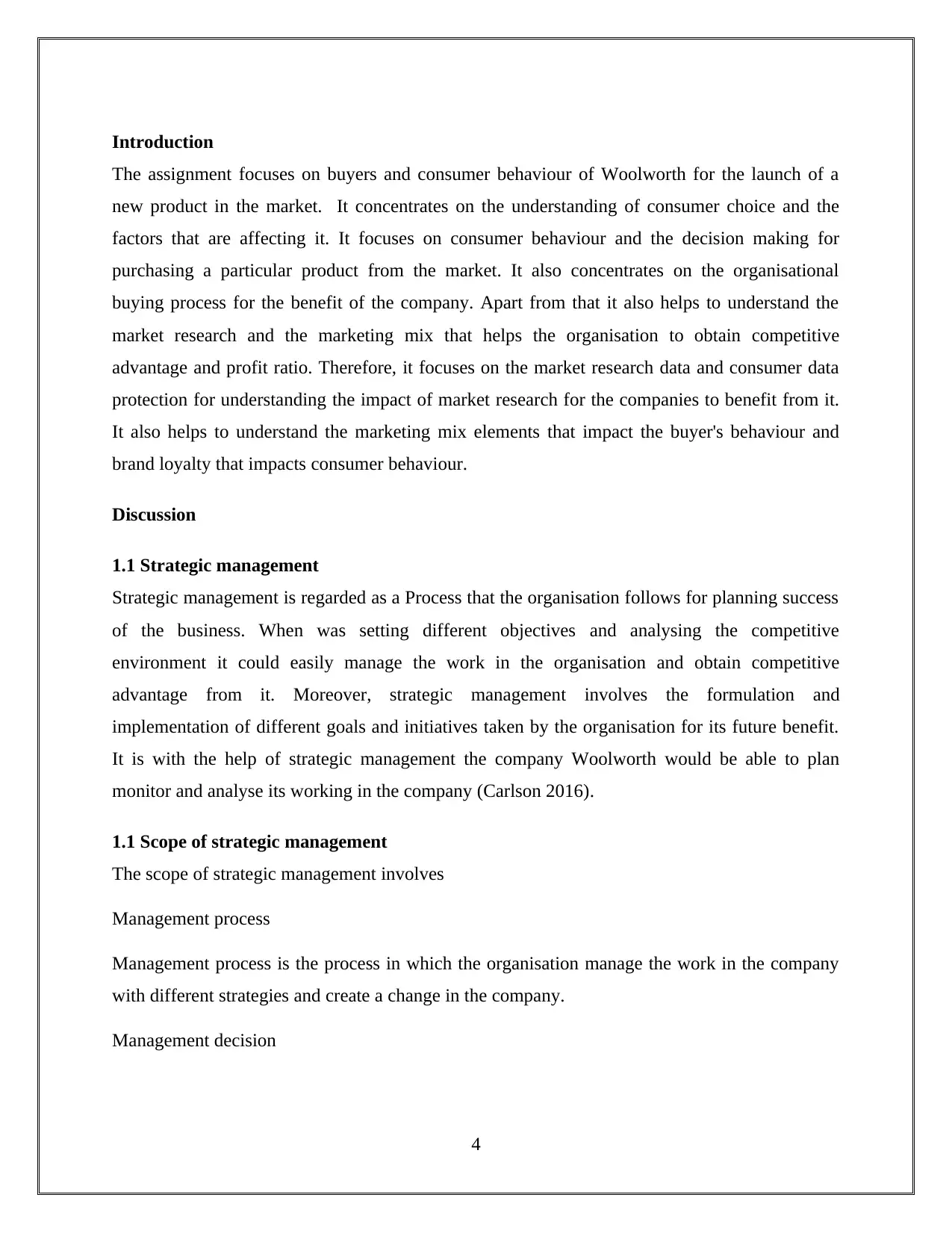
Introduction
The assignment focuses on buyers and consumer behaviour of Woolworth for the launch of a
new product in the market. It concentrates on the understanding of consumer choice and the
factors that are affecting it. It focuses on consumer behaviour and the decision making for
purchasing a particular product from the market. It also concentrates on the organisational
buying process for the benefit of the company. Apart from that it also helps to understand the
market research and the marketing mix that helps the organisation to obtain competitive
advantage and profit ratio. Therefore, it focuses on the market research data and consumer data
protection for understanding the impact of market research for the companies to benefit from it.
It also helps to understand the marketing mix elements that impact the buyer's behaviour and
brand loyalty that impacts consumer behaviour.
Discussion
1.1 Strategic management
Strategic management is regarded as a Process that the organisation follows for planning success
of the business. When was setting different objectives and analysing the competitive
environment it could easily manage the work in the organisation and obtain competitive
advantage from it. Moreover, strategic management involves the formulation and
implementation of different goals and initiatives taken by the organisation for its future benefit.
It is with the help of strategic management the company Woolworth would be able to plan
monitor and analyse its working in the company (Carlson 2016).
1.1 Scope of strategic management
The scope of strategic management involves
Management process
Management process is the process in which the organisation manage the work in the company
with different strategies and create a change in the company.
Management decision
4
The assignment focuses on buyers and consumer behaviour of Woolworth for the launch of a
new product in the market. It concentrates on the understanding of consumer choice and the
factors that are affecting it. It focuses on consumer behaviour and the decision making for
purchasing a particular product from the market. It also concentrates on the organisational
buying process for the benefit of the company. Apart from that it also helps to understand the
market research and the marketing mix that helps the organisation to obtain competitive
advantage and profit ratio. Therefore, it focuses on the market research data and consumer data
protection for understanding the impact of market research for the companies to benefit from it.
It also helps to understand the marketing mix elements that impact the buyer's behaviour and
brand loyalty that impacts consumer behaviour.
Discussion
1.1 Strategic management
Strategic management is regarded as a Process that the organisation follows for planning success
of the business. When was setting different objectives and analysing the competitive
environment it could easily manage the work in the organisation and obtain competitive
advantage from it. Moreover, strategic management involves the formulation and
implementation of different goals and initiatives taken by the organisation for its future benefit.
It is with the help of strategic management the company Woolworth would be able to plan
monitor and analyse its working in the company (Carlson 2016).
1.1 Scope of strategic management
The scope of strategic management involves
Management process
Management process is the process in which the organisation manage the work in the company
with different strategies and create a change in the company.
Management decision
4
Paraphrase This Document
Need a fresh take? Get an instant paraphrase of this document with our AI Paraphraser
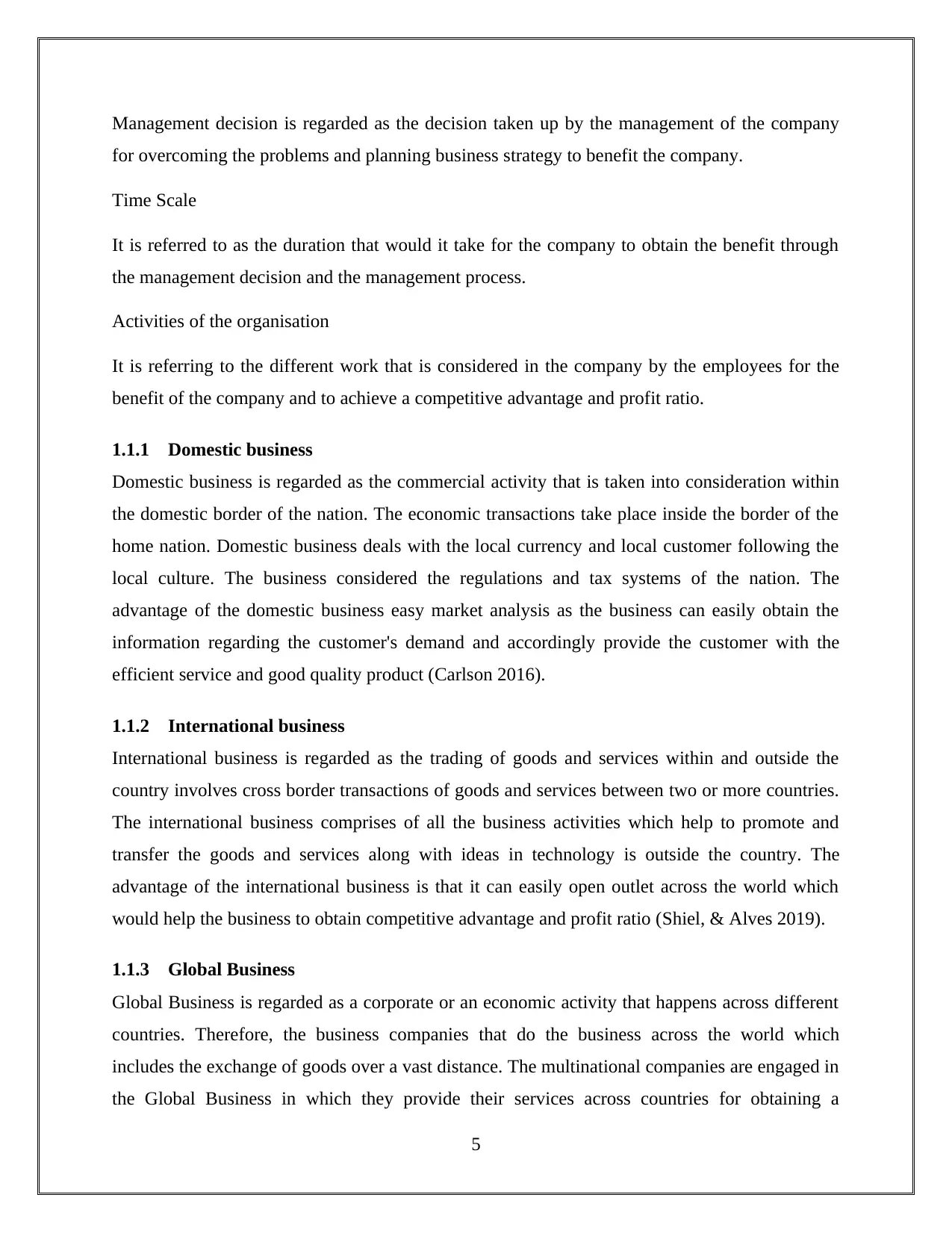
Management decision is regarded as the decision taken up by the management of the company
for overcoming the problems and planning business strategy to benefit the company.
Time Scale
It is referred to as the duration that would it take for the company to obtain the benefit through
the management decision and the management process.
Activities of the organisation
It is referring to the different work that is considered in the company by the employees for the
benefit of the company and to achieve a competitive advantage and profit ratio.
1.1.1 Domestic business
Domestic business is regarded as the commercial activity that is taken into consideration within
the domestic border of the nation. The economic transactions take place inside the border of the
home nation. Domestic business deals with the local currency and local customer following the
local culture. The business considered the regulations and tax systems of the nation. The
advantage of the domestic business easy market analysis as the business can easily obtain the
information regarding the customer's demand and accordingly provide the customer with the
efficient service and good quality product (Carlson 2016).
1.1.2 International business
International business is regarded as the trading of goods and services within and outside the
country involves cross border transactions of goods and services between two or more countries.
The international business comprises of all the business activities which help to promote and
transfer the goods and services along with ideas in technology is outside the country. The
advantage of the international business is that it can easily open outlet across the world which
would help the business to obtain competitive advantage and profit ratio (Shiel, & Alves 2019).
1.1.3 Global Business
Global Business is regarded as a corporate or an economic activity that happens across different
countries. Therefore, the business companies that do the business across the world which
includes the exchange of goods over a vast distance. The multinational companies are engaged in
the Global Business in which they provide their services across countries for obtaining a
5
for overcoming the problems and planning business strategy to benefit the company.
Time Scale
It is referred to as the duration that would it take for the company to obtain the benefit through
the management decision and the management process.
Activities of the organisation
It is referring to the different work that is considered in the company by the employees for the
benefit of the company and to achieve a competitive advantage and profit ratio.
1.1.1 Domestic business
Domestic business is regarded as the commercial activity that is taken into consideration within
the domestic border of the nation. The economic transactions take place inside the border of the
home nation. Domestic business deals with the local currency and local customer following the
local culture. The business considered the regulations and tax systems of the nation. The
advantage of the domestic business easy market analysis as the business can easily obtain the
information regarding the customer's demand and accordingly provide the customer with the
efficient service and good quality product (Carlson 2016).
1.1.2 International business
International business is regarded as the trading of goods and services within and outside the
country involves cross border transactions of goods and services between two or more countries.
The international business comprises of all the business activities which help to promote and
transfer the goods and services along with ideas in technology is outside the country. The
advantage of the international business is that it can easily open outlet across the world which
would help the business to obtain competitive advantage and profit ratio (Shiel, & Alves 2019).
1.1.3 Global Business
Global Business is regarded as a corporate or an economic activity that happens across different
countries. Therefore, the business companies that do the business across the world which
includes the exchange of goods over a vast distance. The multinational companies are engaged in
the Global Business in which they provide their services across countries for obtaining a
5
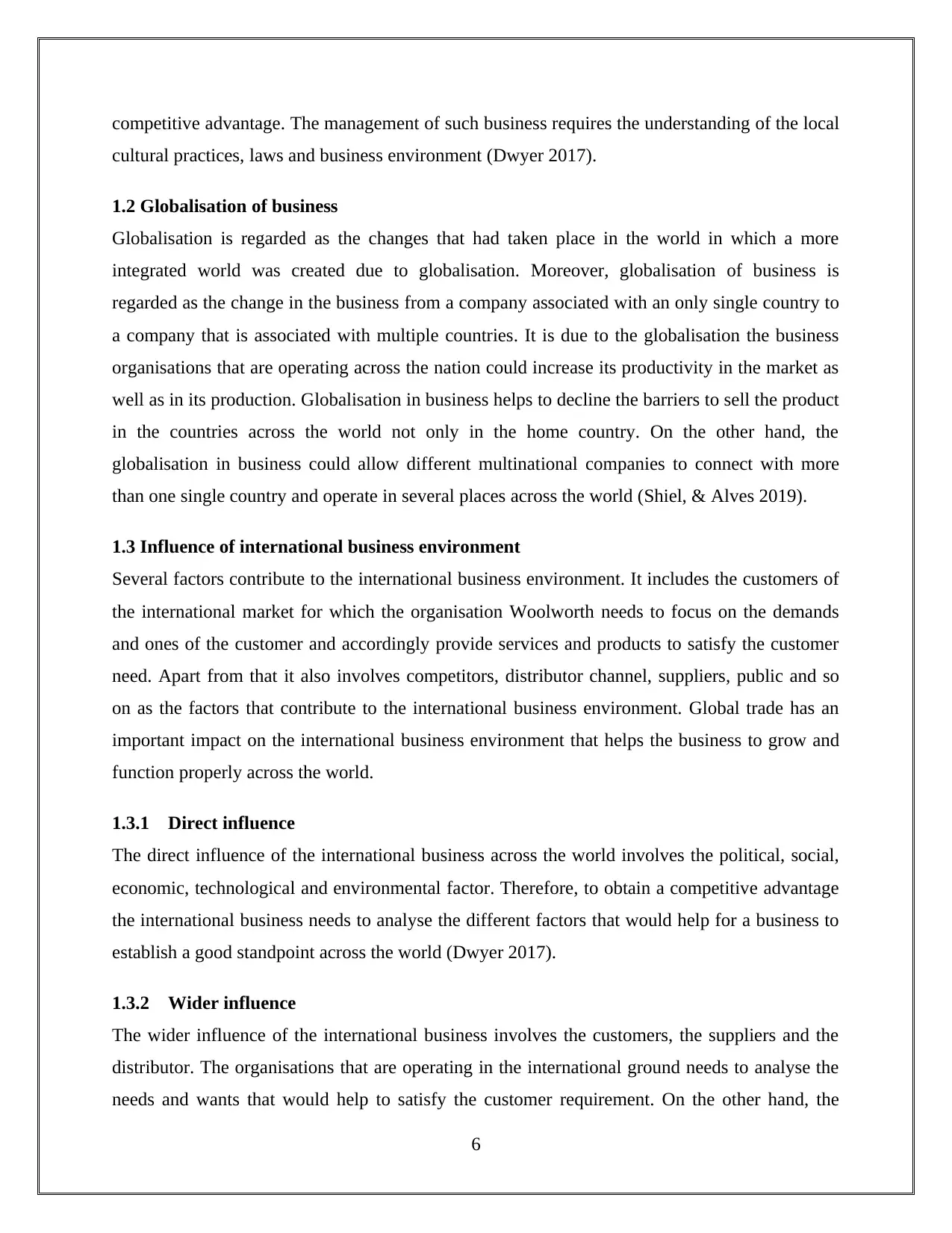
competitive advantage. The management of such business requires the understanding of the local
cultural practices, laws and business environment (Dwyer 2017).
1.2 Globalisation of business
Globalisation is regarded as the changes that had taken place in the world in which a more
integrated world was created due to globalisation. Moreover, globalisation of business is
regarded as the change in the business from a company associated with an only single country to
a company that is associated with multiple countries. It is due to the globalisation the business
organisations that are operating across the nation could increase its productivity in the market as
well as in its production. Globalisation in business helps to decline the barriers to sell the product
in the countries across the world not only in the home country. On the other hand, the
globalisation in business could allow different multinational companies to connect with more
than one single country and operate in several places across the world (Shiel, & Alves 2019).
1.3 Influence of international business environment
Several factors contribute to the international business environment. It includes the customers of
the international market for which the organisation Woolworth needs to focus on the demands
and ones of the customer and accordingly provide services and products to satisfy the customer
need. Apart from that it also involves competitors, distributor channel, suppliers, public and so
on as the factors that contribute to the international business environment. Global trade has an
important impact on the international business environment that helps the business to grow and
function properly across the world.
1.3.1 Direct influence
The direct influence of the international business across the world involves the political, social,
economic, technological and environmental factor. Therefore, to obtain a competitive advantage
the international business needs to analyse the different factors that would help for a business to
establish a good standpoint across the world (Dwyer 2017).
1.3.2 Wider influence
The wider influence of the international business involves the customers, the suppliers and the
distributor. The organisations that are operating in the international ground needs to analyse the
needs and wants that would help to satisfy the customer requirement. On the other hand, the
6
cultural practices, laws and business environment (Dwyer 2017).
1.2 Globalisation of business
Globalisation is regarded as the changes that had taken place in the world in which a more
integrated world was created due to globalisation. Moreover, globalisation of business is
regarded as the change in the business from a company associated with an only single country to
a company that is associated with multiple countries. It is due to the globalisation the business
organisations that are operating across the nation could increase its productivity in the market as
well as in its production. Globalisation in business helps to decline the barriers to sell the product
in the countries across the world not only in the home country. On the other hand, the
globalisation in business could allow different multinational companies to connect with more
than one single country and operate in several places across the world (Shiel, & Alves 2019).
1.3 Influence of international business environment
Several factors contribute to the international business environment. It includes the customers of
the international market for which the organisation Woolworth needs to focus on the demands
and ones of the customer and accordingly provide services and products to satisfy the customer
need. Apart from that it also involves competitors, distributor channel, suppliers, public and so
on as the factors that contribute to the international business environment. Global trade has an
important impact on the international business environment that helps the business to grow and
function properly across the world.
1.3.1 Direct influence
The direct influence of the international business across the world involves the political, social,
economic, technological and environmental factor. Therefore, to obtain a competitive advantage
the international business needs to analyse the different factors that would help for a business to
establish a good standpoint across the world (Dwyer 2017).
1.3.2 Wider influence
The wider influence of the international business involves the customers, the suppliers and the
distributor. The organisations that are operating in the international ground needs to analyse the
needs and wants that would help to satisfy the customer requirement. On the other hand, the
6
⊘ This is a preview!⊘
Do you want full access?
Subscribe today to unlock all pages.

Trusted by 1+ million students worldwide
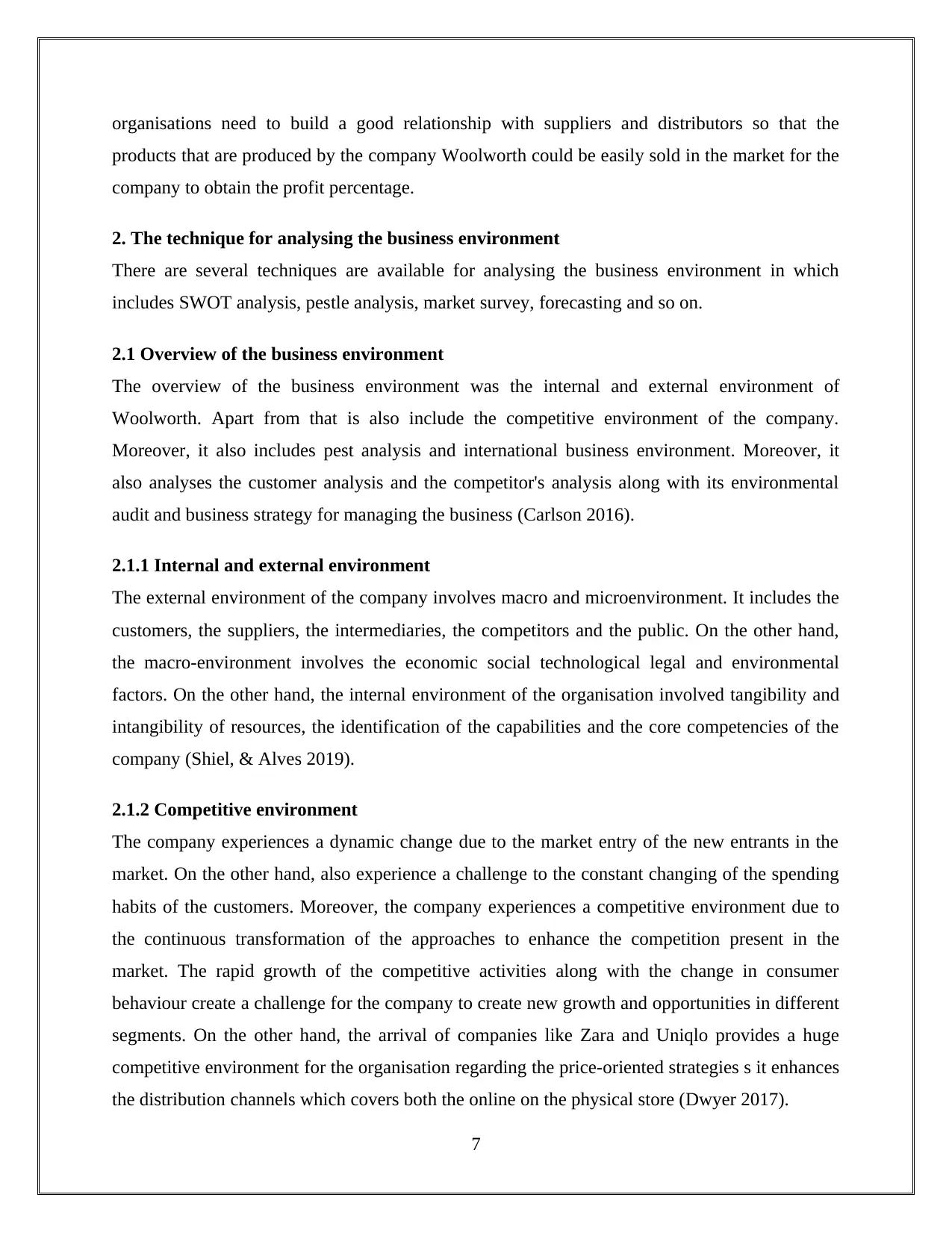
organisations need to build a good relationship with suppliers and distributors so that the
products that are produced by the company Woolworth could be easily sold in the market for the
company to obtain the profit percentage.
2. The technique for analysing the business environment
There are several techniques are available for analysing the business environment in which
includes SWOT analysis, pestle analysis, market survey, forecasting and so on.
2.1 Overview of the business environment
The overview of the business environment was the internal and external environment of
Woolworth. Apart from that is also include the competitive environment of the company.
Moreover, it also includes pest analysis and international business environment. Moreover, it
also analyses the customer analysis and the competitor's analysis along with its environmental
audit and business strategy for managing the business (Carlson 2016).
2.1.1 Internal and external environment
The external environment of the company involves macro and microenvironment. It includes the
customers, the suppliers, the intermediaries, the competitors and the public. On the other hand,
the macro-environment involves the economic social technological legal and environmental
factors. On the other hand, the internal environment of the organisation involved tangibility and
intangibility of resources, the identification of the capabilities and the core competencies of the
company (Shiel, & Alves 2019).
2.1.2 Competitive environment
The company experiences a dynamic change due to the market entry of the new entrants in the
market. On the other hand, also experience a challenge to the constant changing of the spending
habits of the customers. Moreover, the company experiences a competitive environment due to
the continuous transformation of the approaches to enhance the competition present in the
market. The rapid growth of the competitive activities along with the change in consumer
behaviour create a challenge for the company to create new growth and opportunities in different
segments. On the other hand, the arrival of companies like Zara and Uniqlo provides a huge
competitive environment for the organisation regarding the price-oriented strategies s it enhances
the distribution channels which covers both the online on the physical store (Dwyer 2017).
7
products that are produced by the company Woolworth could be easily sold in the market for the
company to obtain the profit percentage.
2. The technique for analysing the business environment
There are several techniques are available for analysing the business environment in which
includes SWOT analysis, pestle analysis, market survey, forecasting and so on.
2.1 Overview of the business environment
The overview of the business environment was the internal and external environment of
Woolworth. Apart from that is also include the competitive environment of the company.
Moreover, it also includes pest analysis and international business environment. Moreover, it
also analyses the customer analysis and the competitor's analysis along with its environmental
audit and business strategy for managing the business (Carlson 2016).
2.1.1 Internal and external environment
The external environment of the company involves macro and microenvironment. It includes the
customers, the suppliers, the intermediaries, the competitors and the public. On the other hand,
the macro-environment involves the economic social technological legal and environmental
factors. On the other hand, the internal environment of the organisation involved tangibility and
intangibility of resources, the identification of the capabilities and the core competencies of the
company (Shiel, & Alves 2019).
2.1.2 Competitive environment
The company experiences a dynamic change due to the market entry of the new entrants in the
market. On the other hand, also experience a challenge to the constant changing of the spending
habits of the customers. Moreover, the company experiences a competitive environment due to
the continuous transformation of the approaches to enhance the competition present in the
market. The rapid growth of the competitive activities along with the change in consumer
behaviour create a challenge for the company to create new growth and opportunities in different
segments. On the other hand, the arrival of companies like Zara and Uniqlo provides a huge
competitive environment for the organisation regarding the price-oriented strategies s it enhances
the distribution channels which covers both the online on the physical store (Dwyer 2017).
7
Paraphrase This Document
Need a fresh take? Get an instant paraphrase of this document with our AI Paraphraser
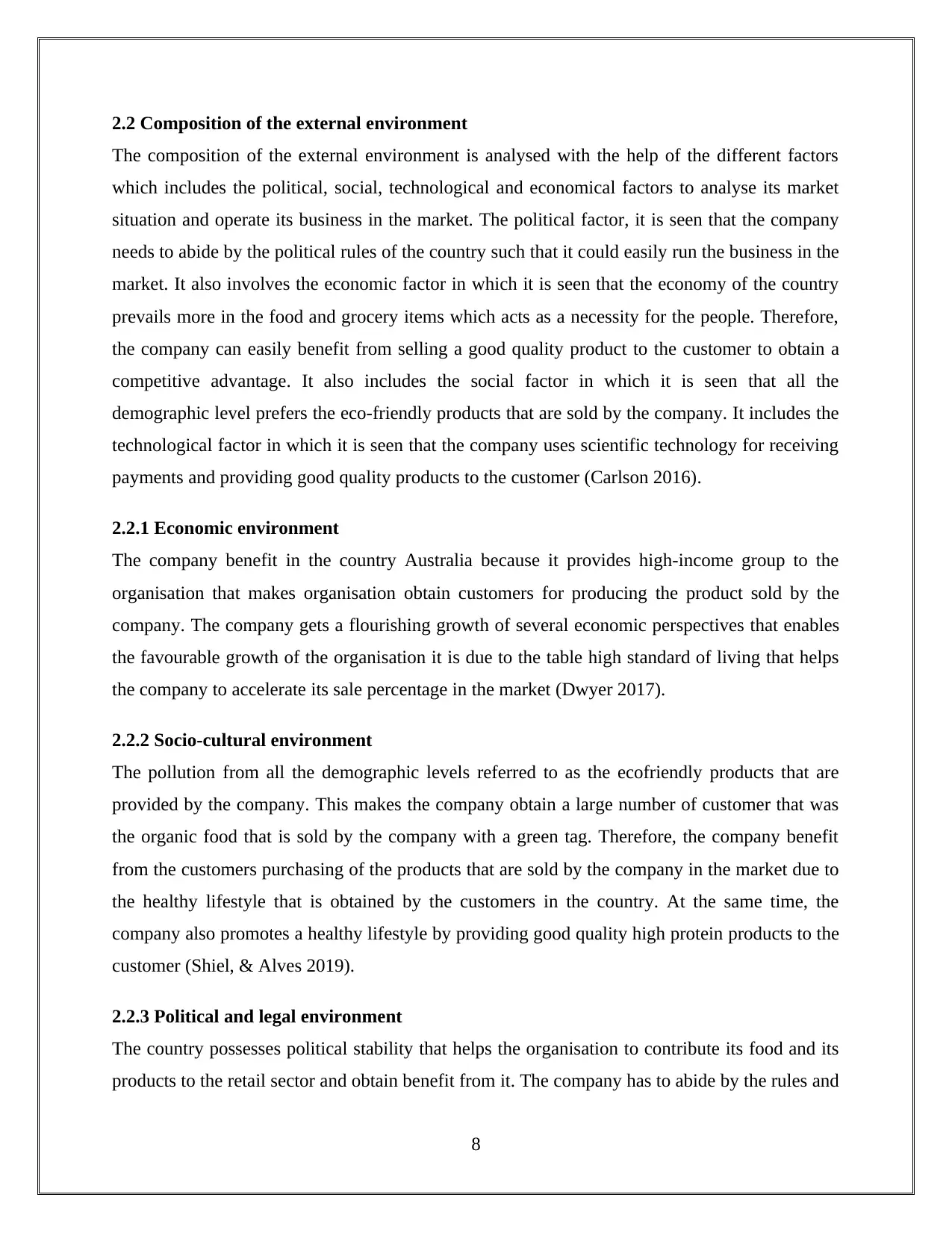
2.2 Composition of the external environment
The composition of the external environment is analysed with the help of the different factors
which includes the political, social, technological and economical factors to analyse its market
situation and operate its business in the market. The political factor, it is seen that the company
needs to abide by the political rules of the country such that it could easily run the business in the
market. It also involves the economic factor in which it is seen that the economy of the country
prevails more in the food and grocery items which acts as a necessity for the people. Therefore,
the company can easily benefit from selling a good quality product to the customer to obtain a
competitive advantage. It also includes the social factor in which it is seen that all the
demographic level prefers the eco-friendly products that are sold by the company. It includes the
technological factor in which it is seen that the company uses scientific technology for receiving
payments and providing good quality products to the customer (Carlson 2016).
2.2.1 Economic environment
The company benefit in the country Australia because it provides high-income group to the
organisation that makes organisation obtain customers for producing the product sold by the
company. The company gets a flourishing growth of several economic perspectives that enables
the favourable growth of the organisation it is due to the table high standard of living that helps
the company to accelerate its sale percentage in the market (Dwyer 2017).
2.2.2 Socio-cultural environment
The pollution from all the demographic levels referred to as the ecofriendly products that are
provided by the company. This makes the company obtain a large number of customer that was
the organic food that is sold by the company with a green tag. Therefore, the company benefit
from the customers purchasing of the products that are sold by the company in the market due to
the healthy lifestyle that is obtained by the customers in the country. At the same time, the
company also promotes a healthy lifestyle by providing good quality high protein products to the
customer (Shiel, & Alves 2019).
2.2.3 Political and legal environment
The country possesses political stability that helps the organisation to contribute its food and its
products to the retail sector and obtain benefit from it. The company has to abide by the rules and
8
The composition of the external environment is analysed with the help of the different factors
which includes the political, social, technological and economical factors to analyse its market
situation and operate its business in the market. The political factor, it is seen that the company
needs to abide by the political rules of the country such that it could easily run the business in the
market. It also involves the economic factor in which it is seen that the economy of the country
prevails more in the food and grocery items which acts as a necessity for the people. Therefore,
the company can easily benefit from selling a good quality product to the customer to obtain a
competitive advantage. It also includes the social factor in which it is seen that all the
demographic level prefers the eco-friendly products that are sold by the company. It includes the
technological factor in which it is seen that the company uses scientific technology for receiving
payments and providing good quality products to the customer (Carlson 2016).
2.2.1 Economic environment
The company benefit in the country Australia because it provides high-income group to the
organisation that makes organisation obtain customers for producing the product sold by the
company. The company gets a flourishing growth of several economic perspectives that enables
the favourable growth of the organisation it is due to the table high standard of living that helps
the company to accelerate its sale percentage in the market (Dwyer 2017).
2.2.2 Socio-cultural environment
The pollution from all the demographic levels referred to as the ecofriendly products that are
provided by the company. This makes the company obtain a large number of customer that was
the organic food that is sold by the company with a green tag. Therefore, the company benefit
from the customers purchasing of the products that are sold by the company in the market due to
the healthy lifestyle that is obtained by the customers in the country. At the same time, the
company also promotes a healthy lifestyle by providing good quality high protein products to the
customer (Shiel, & Alves 2019).
2.2.3 Political and legal environment
The country possesses political stability that helps the organisation to contribute its food and its
products to the retail sector and obtain benefit from it. The company has to abide by the rules and
8
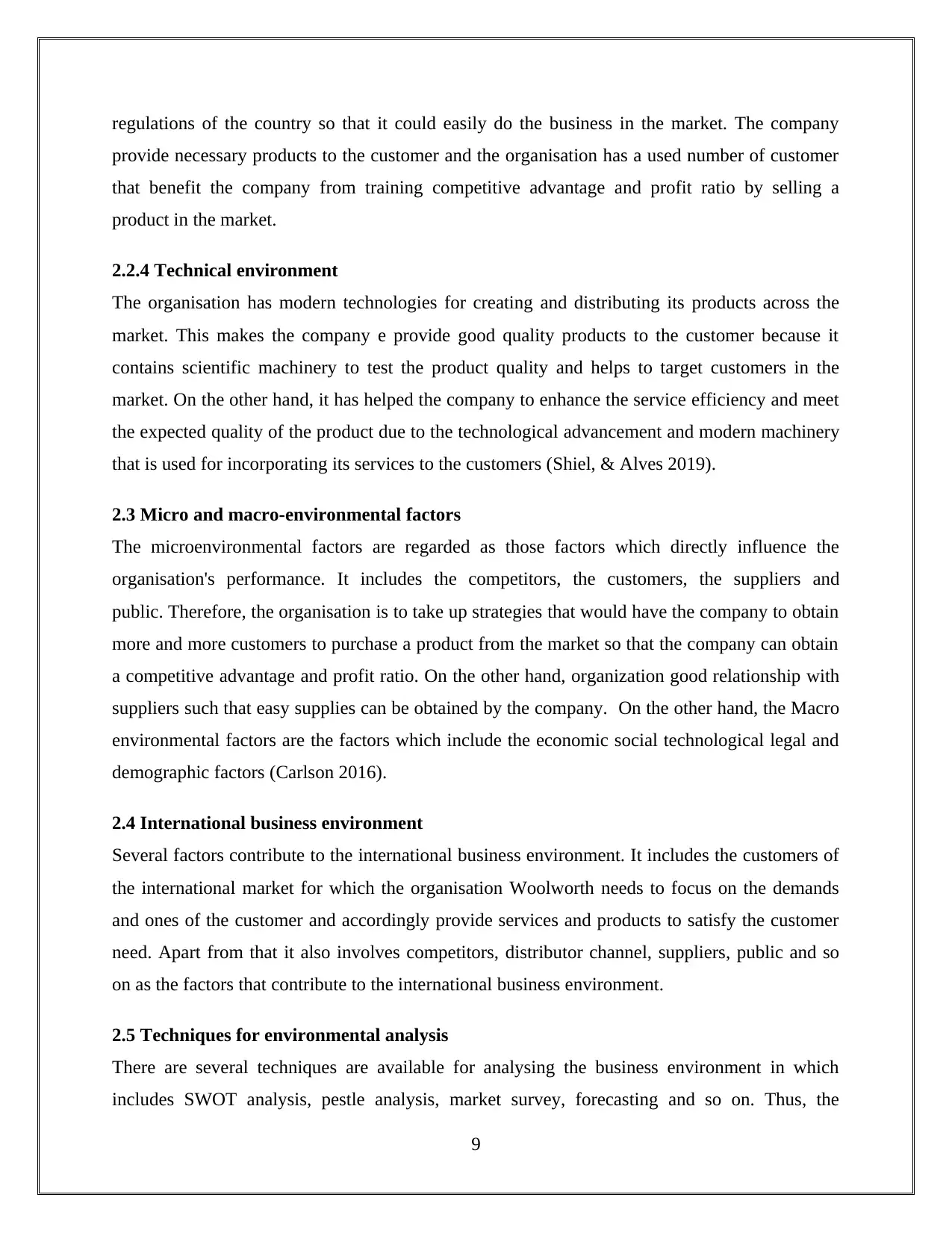
regulations of the country so that it could easily do the business in the market. The company
provide necessary products to the customer and the organisation has a used number of customer
that benefit the company from training competitive advantage and profit ratio by selling a
product in the market.
2.2.4 Technical environment
The organisation has modern technologies for creating and distributing its products across the
market. This makes the company e provide good quality products to the customer because it
contains scientific machinery to test the product quality and helps to target customers in the
market. On the other hand, it has helped the company to enhance the service efficiency and meet
the expected quality of the product due to the technological advancement and modern machinery
that is used for incorporating its services to the customers (Shiel, & Alves 2019).
2.3 Micro and macro-environmental factors
The microenvironmental factors are regarded as those factors which directly influence the
organisation's performance. It includes the competitors, the customers, the suppliers and
public. Therefore, the organisation is to take up strategies that would have the company to obtain
more and more customers to purchase a product from the market so that the company can obtain
a competitive advantage and profit ratio. On the other hand, organization good relationship with
suppliers such that easy supplies can be obtained by the company. On the other hand, the Macro
environmental factors are the factors which include the economic social technological legal and
demographic factors (Carlson 2016).
2.4 International business environment
Several factors contribute to the international business environment. It includes the customers of
the international market for which the organisation Woolworth needs to focus on the demands
and ones of the customer and accordingly provide services and products to satisfy the customer
need. Apart from that it also involves competitors, distributor channel, suppliers, public and so
on as the factors that contribute to the international business environment.
2.5 Techniques for environmental analysis
There are several techniques are available for analysing the business environment in which
includes SWOT analysis, pestle analysis, market survey, forecasting and so on. Thus, the
9
provide necessary products to the customer and the organisation has a used number of customer
that benefit the company from training competitive advantage and profit ratio by selling a
product in the market.
2.2.4 Technical environment
The organisation has modern technologies for creating and distributing its products across the
market. This makes the company e provide good quality products to the customer because it
contains scientific machinery to test the product quality and helps to target customers in the
market. On the other hand, it has helped the company to enhance the service efficiency and meet
the expected quality of the product due to the technological advancement and modern machinery
that is used for incorporating its services to the customers (Shiel, & Alves 2019).
2.3 Micro and macro-environmental factors
The microenvironmental factors are regarded as those factors which directly influence the
organisation's performance. It includes the competitors, the customers, the suppliers and
public. Therefore, the organisation is to take up strategies that would have the company to obtain
more and more customers to purchase a product from the market so that the company can obtain
a competitive advantage and profit ratio. On the other hand, organization good relationship with
suppliers such that easy supplies can be obtained by the company. On the other hand, the Macro
environmental factors are the factors which include the economic social technological legal and
demographic factors (Carlson 2016).
2.4 International business environment
Several factors contribute to the international business environment. It includes the customers of
the international market for which the organisation Woolworth needs to focus on the demands
and ones of the customer and accordingly provide services and products to satisfy the customer
need. Apart from that it also involves competitors, distributor channel, suppliers, public and so
on as the factors that contribute to the international business environment.
2.5 Techniques for environmental analysis
There are several techniques are available for analysing the business environment in which
includes SWOT analysis, pestle analysis, market survey, forecasting and so on. Thus, the
9
⊘ This is a preview!⊘
Do you want full access?
Subscribe today to unlock all pages.

Trusted by 1+ million students worldwide
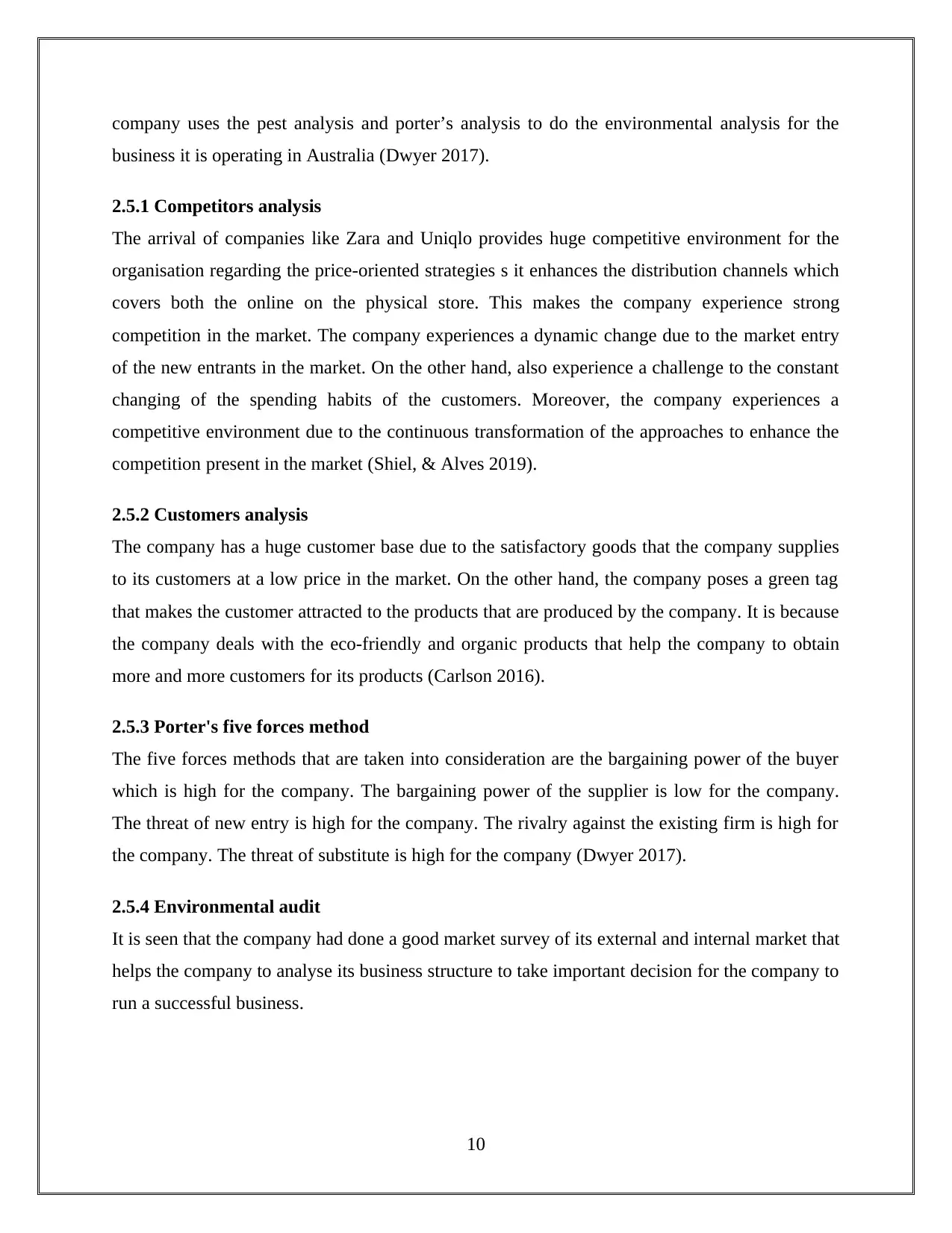
company uses the pest analysis and porter’s analysis to do the environmental analysis for the
business it is operating in Australia (Dwyer 2017).
2.5.1 Competitors analysis
The arrival of companies like Zara and Uniqlo provides huge competitive environment for the
organisation regarding the price-oriented strategies s it enhances the distribution channels which
covers both the online on the physical store. This makes the company experience strong
competition in the market. The company experiences a dynamic change due to the market entry
of the new entrants in the market. On the other hand, also experience a challenge to the constant
changing of the spending habits of the customers. Moreover, the company experiences a
competitive environment due to the continuous transformation of the approaches to enhance the
competition present in the market (Shiel, & Alves 2019).
2.5.2 Customers analysis
The company has a huge customer base due to the satisfactory goods that the company supplies
to its customers at a low price in the market. On the other hand, the company poses a green tag
that makes the customer attracted to the products that are produced by the company. It is because
the company deals with the eco-friendly and organic products that help the company to obtain
more and more customers for its products (Carlson 2016).
2.5.3 Porter's five forces method
The five forces methods that are taken into consideration are the bargaining power of the buyer
which is high for the company. The bargaining power of the supplier is low for the company.
The threat of new entry is high for the company. The rivalry against the existing firm is high for
the company. The threat of substitute is high for the company (Dwyer 2017).
2.5.4 Environmental audit
It is seen that the company had done a good market survey of its external and internal market that
helps the company to analyse its business structure to take important decision for the company to
run a successful business.
10
business it is operating in Australia (Dwyer 2017).
2.5.1 Competitors analysis
The arrival of companies like Zara and Uniqlo provides huge competitive environment for the
organisation regarding the price-oriented strategies s it enhances the distribution channels which
covers both the online on the physical store. This makes the company experience strong
competition in the market. The company experiences a dynamic change due to the market entry
of the new entrants in the market. On the other hand, also experience a challenge to the constant
changing of the spending habits of the customers. Moreover, the company experiences a
competitive environment due to the continuous transformation of the approaches to enhance the
competition present in the market (Shiel, & Alves 2019).
2.5.2 Customers analysis
The company has a huge customer base due to the satisfactory goods that the company supplies
to its customers at a low price in the market. On the other hand, the company poses a green tag
that makes the customer attracted to the products that are produced by the company. It is because
the company deals with the eco-friendly and organic products that help the company to obtain
more and more customers for its products (Carlson 2016).
2.5.3 Porter's five forces method
The five forces methods that are taken into consideration are the bargaining power of the buyer
which is high for the company. The bargaining power of the supplier is low for the company.
The threat of new entry is high for the company. The rivalry against the existing firm is high for
the company. The threat of substitute is high for the company (Dwyer 2017).
2.5.4 Environmental audit
It is seen that the company had done a good market survey of its external and internal market that
helps the company to analyse its business structure to take important decision for the company to
run a successful business.
10
Paraphrase This Document
Need a fresh take? Get an instant paraphrase of this document with our AI Paraphraser
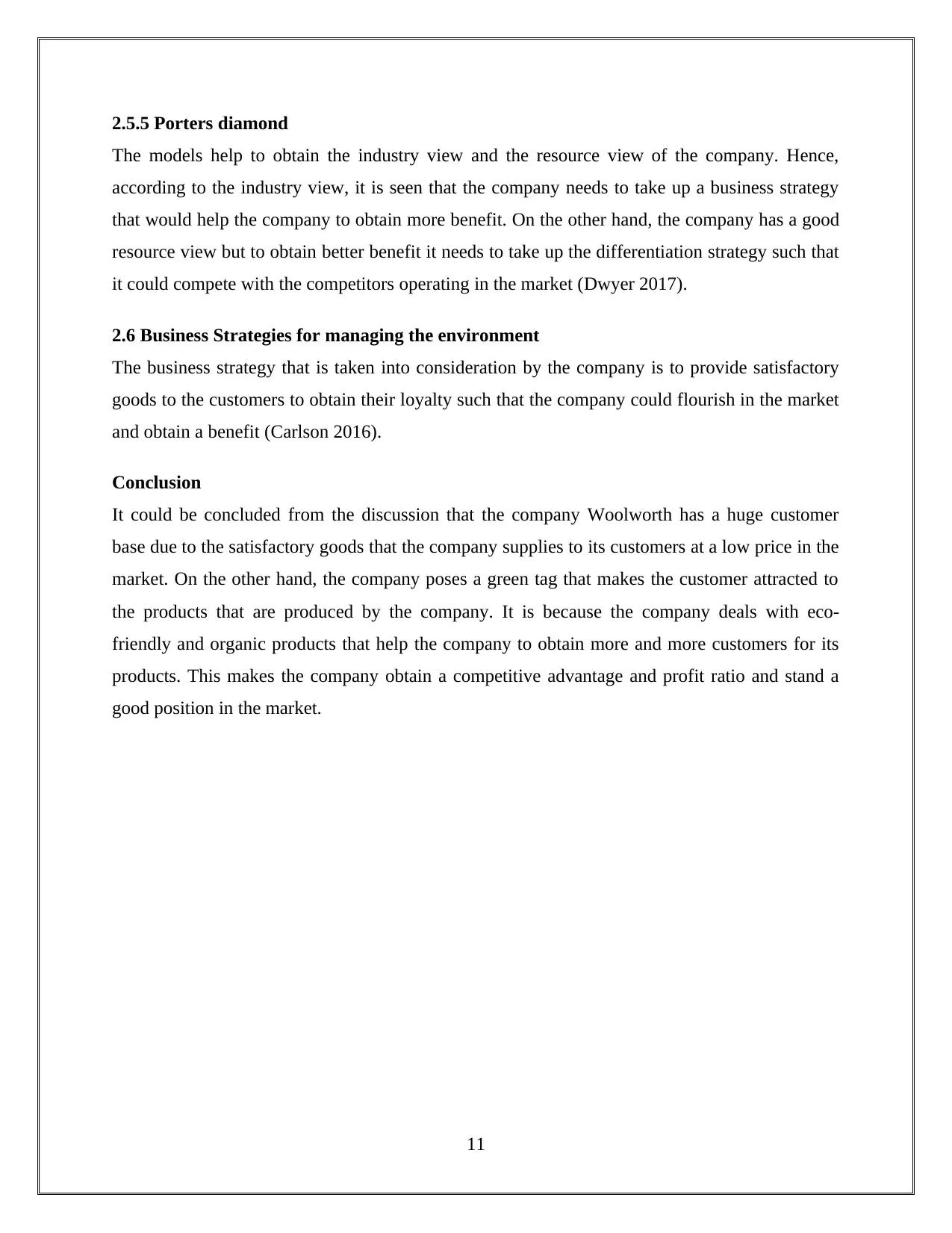
2.5.5 Porters diamond
The models help to obtain the industry view and the resource view of the company. Hence,
according to the industry view, it is seen that the company needs to take up a business strategy
that would help the company to obtain more benefit. On the other hand, the company has a good
resource view but to obtain better benefit it needs to take up the differentiation strategy such that
it could compete with the competitors operating in the market (Dwyer 2017).
2.6 Business Strategies for managing the environment
The business strategy that is taken into consideration by the company is to provide satisfactory
goods to the customers to obtain their loyalty such that the company could flourish in the market
and obtain a benefit (Carlson 2016).
Conclusion
It could be concluded from the discussion that the company Woolworth has a huge customer
base due to the satisfactory goods that the company supplies to its customers at a low price in the
market. On the other hand, the company poses a green tag that makes the customer attracted to
the products that are produced by the company. It is because the company deals with eco-
friendly and organic products that help the company to obtain more and more customers for its
products. This makes the company obtain a competitive advantage and profit ratio and stand a
good position in the market.
11
The models help to obtain the industry view and the resource view of the company. Hence,
according to the industry view, it is seen that the company needs to take up a business strategy
that would help the company to obtain more benefit. On the other hand, the company has a good
resource view but to obtain better benefit it needs to take up the differentiation strategy such that
it could compete with the competitors operating in the market (Dwyer 2017).
2.6 Business Strategies for managing the environment
The business strategy that is taken into consideration by the company is to provide satisfactory
goods to the customers to obtain their loyalty such that the company could flourish in the market
and obtain a benefit (Carlson 2016).
Conclusion
It could be concluded from the discussion that the company Woolworth has a huge customer
base due to the satisfactory goods that the company supplies to its customers at a low price in the
market. On the other hand, the company poses a green tag that makes the customer attracted to
the products that are produced by the company. It is because the company deals with eco-
friendly and organic products that help the company to obtain more and more customers for its
products. This makes the company obtain a competitive advantage and profit ratio and stand a
good position in the market.
11
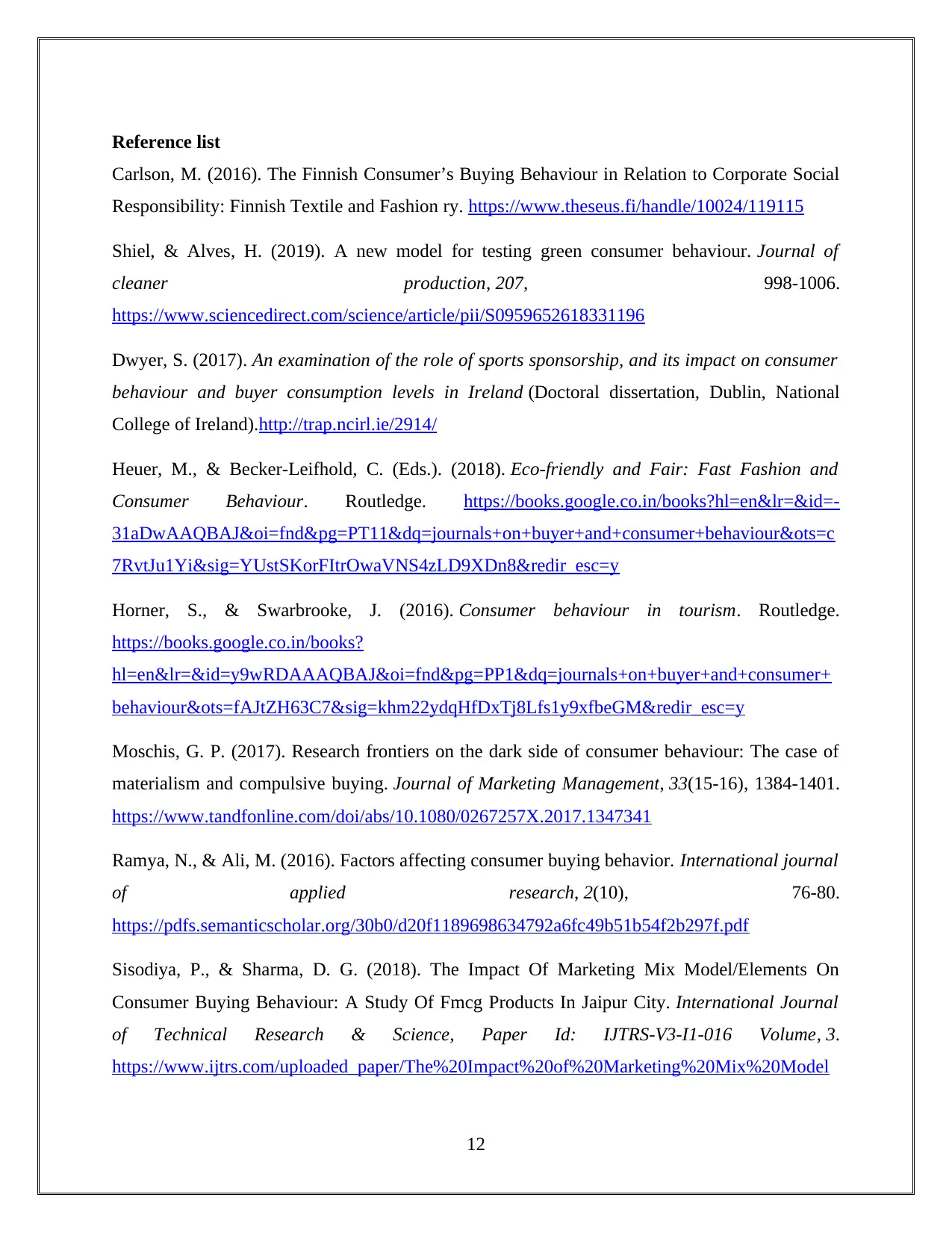
Reference list
Carlson, M. (2016). The Finnish Consumer’s Buying Behaviour in Relation to Corporate Social
Responsibility: Finnish Textile and Fashion ry. https://www.theseus.fi/handle/10024/119115
Shiel, & Alves, H. (2019). A new model for testing green consumer behaviour. Journal of
cleaner production, 207, 998-1006.
https://www.sciencedirect.com/science/article/pii/S0959652618331196
Dwyer, S. (2017). An examination of the role of sports sponsorship, and its impact on consumer
behaviour and buyer consumption levels in Ireland (Doctoral dissertation, Dublin, National
College of Ireland).http://trap.ncirl.ie/2914/
Heuer, M., & Becker-Leifhold, C. (Eds.). (2018). Eco-friendly and Fair: Fast Fashion and
Consumer Behaviour. Routledge. https://books.google.co.in/books?hl=en&lr=&id=-
31aDwAAQBAJ&oi=fnd&pg=PT11&dq=journals+on+buyer+and+consumer+behaviour&ots=c
7RvtJu1Yi&sig=YUstSKorFItrOwaVNS4zLD9XDn8&redir_esc=y
Horner, S., & Swarbrooke, J. (2016). Consumer behaviour in tourism. Routledge.
https://books.google.co.in/books?
hl=en&lr=&id=y9wRDAAAQBAJ&oi=fnd&pg=PP1&dq=journals+on+buyer+and+consumer+
behaviour&ots=fAJtZH63C7&sig=khm22ydqHfDxTj8Lfs1y9xfbeGM&redir_esc=y
Moschis, G. P. (2017). Research frontiers on the dark side of consumer behaviour: The case of
materialism and compulsive buying. Journal of Marketing Management, 33(15-16), 1384-1401.
https://www.tandfonline.com/doi/abs/10.1080/0267257X.2017.1347341
Ramya, N., & Ali, M. (2016). Factors affecting consumer buying behavior. International journal
of applied research, 2(10), 76-80.
https://pdfs.semanticscholar.org/30b0/d20f1189698634792a6fc49b51b54f2b297f.pdf
Sisodiya, P., & Sharma, D. G. (2018). The Impact Of Marketing Mix Model/Elements On
Consumer Buying Behaviour: A Study Of Fmcg Products In Jaipur City. International Journal
of Technical Research & Science, Paper Id: IJTRS-V3-I1-016 Volume, 3.
https://www.ijtrs.com/uploaded_paper/The%20Impact%20of%20Marketing%20Mix%20Model
12
Carlson, M. (2016). The Finnish Consumer’s Buying Behaviour in Relation to Corporate Social
Responsibility: Finnish Textile and Fashion ry. https://www.theseus.fi/handle/10024/119115
Shiel, & Alves, H. (2019). A new model for testing green consumer behaviour. Journal of
cleaner production, 207, 998-1006.
https://www.sciencedirect.com/science/article/pii/S0959652618331196
Dwyer, S. (2017). An examination of the role of sports sponsorship, and its impact on consumer
behaviour and buyer consumption levels in Ireland (Doctoral dissertation, Dublin, National
College of Ireland).http://trap.ncirl.ie/2914/
Heuer, M., & Becker-Leifhold, C. (Eds.). (2018). Eco-friendly and Fair: Fast Fashion and
Consumer Behaviour. Routledge. https://books.google.co.in/books?hl=en&lr=&id=-
31aDwAAQBAJ&oi=fnd&pg=PT11&dq=journals+on+buyer+and+consumer+behaviour&ots=c
7RvtJu1Yi&sig=YUstSKorFItrOwaVNS4zLD9XDn8&redir_esc=y
Horner, S., & Swarbrooke, J. (2016). Consumer behaviour in tourism. Routledge.
https://books.google.co.in/books?
hl=en&lr=&id=y9wRDAAAQBAJ&oi=fnd&pg=PP1&dq=journals+on+buyer+and+consumer+
behaviour&ots=fAJtZH63C7&sig=khm22ydqHfDxTj8Lfs1y9xfbeGM&redir_esc=y
Moschis, G. P. (2017). Research frontiers on the dark side of consumer behaviour: The case of
materialism and compulsive buying. Journal of Marketing Management, 33(15-16), 1384-1401.
https://www.tandfonline.com/doi/abs/10.1080/0267257X.2017.1347341
Ramya, N., & Ali, M. (2016). Factors affecting consumer buying behavior. International journal
of applied research, 2(10), 76-80.
https://pdfs.semanticscholar.org/30b0/d20f1189698634792a6fc49b51b54f2b297f.pdf
Sisodiya, P., & Sharma, D. G. (2018). The Impact Of Marketing Mix Model/Elements On
Consumer Buying Behaviour: A Study Of Fmcg Products In Jaipur City. International Journal
of Technical Research & Science, Paper Id: IJTRS-V3-I1-016 Volume, 3.
https://www.ijtrs.com/uploaded_paper/The%20Impact%20of%20Marketing%20Mix%20Model
12
⊘ This is a preview!⊘
Do you want full access?
Subscribe today to unlock all pages.

Trusted by 1+ million students worldwide
1 out of 13
Related Documents
Your All-in-One AI-Powered Toolkit for Academic Success.
+13062052269
info@desklib.com
Available 24*7 on WhatsApp / Email
![[object Object]](/_next/static/media/star-bottom.7253800d.svg)
Unlock your academic potential
Copyright © 2020–2025 A2Z Services. All Rights Reserved. Developed and managed by ZUCOL.





